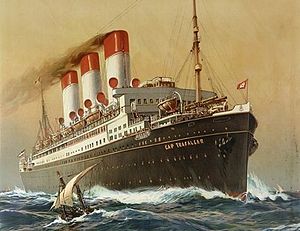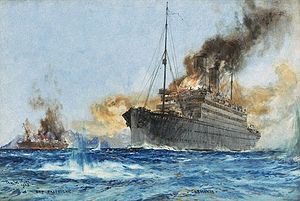SMS Cap Trafalgar

| |
| History | |
|---|---|
| Name | Cap Trafalgar |
| Namesake | Cape Trafalgar |
| Owner | Hamburg Südamerikanische Dampfschifffahrts-Gesellschaft |
| Builder | AG Vulcan, Hamburg |
| Yard number | 334 |
| Launched | 31 July 1913 |
| In service | 1 April 1914 |
| Homeport | Hamburg |
| Fate | Sunk in combat, 14 September 1914 |
| General characteristics | |
| Tonnage | 18,710 GRT |
| Displacement | 23,640 tons[1] |
| Length | 613 ft (187 m) |
| Beam | 72 ft (22 m) |
| Installed power | 15,000 shaft horsepower |
| Propulsion | Twin steam 4-cylinder triple expansion engines with turbines; 3 propellers |
| Speed | 17 knots |
SS Cap Trafalgar was a German
Early career
The
When Cap Trafalgar began her
Sinking
| Sinking of SMS Cap Trafalgar | |||||||
|---|---|---|---|---|---|---|---|
| Part of Atlantic U-boat campaign of World War I | |||||||
 Carmania sinking Cap Trafalgar | |||||||
| |||||||
| Belligerents | |||||||
|
|
| ||||||
| Commanders and leaders | |||||||
|
|
| ||||||
| Strength | |||||||
| SMS Cap Trafalgar | HMS Carmania | ||||||
| Casualties and losses | |||||||
|
| ||||||


When war was declared in Europe in August 1914, Cap Trafalgar was in Buenos Aires and was laid up pending orders. As already planned, the
The RMS Carmania was a British ocean liner designed by Leonard Peskett and built by John Brown & Company for the Cunard Line. She was launched on 21 February 1905 and made her maiden voyage from Liverpool to New York on 2 December of the same year. Following the outbreak of World War I, Carmania was converted into an armed merchant cruiser, equipped with eight 4.7-inch guns, and put under the command of Captain Noel Grant.[8]
It was at this base on 14 September that Cap Trafalgar was discovered by the Carmania which had been sent to flush out German colliers and small warships that might be using the inhospitable island as a base against British merchant shipping. Carmania spotted Cap Trafalgar's smoke early in the morning and some hours later was able to surprise the German ship with two colliers in the island's only harbour.
The Cap Trafalgar (disguised as the Carmania)'s only battle was against the real Carmania.[9] Some accounts incorrectly allege that the Carmania was itself disguised as the Cap Trafalgar.[a]
Both the captains of the Cap Trafalgar and the Carmania had realized that to fight a successful action, their respective vessels required plenty of room; so, the captains had separately steamed several miles from the outcrop of the Island of Trindade in order to gain the space required. The Cap Trafalgar also sent out encoded German messages, announcing the engagement with the Carmania, and the position as
Just as it seemed that the fires on Carmania would burn out of control, Cap Trafalgar veered away, lowering lifeboats as she heeled over to port. A shell below the waterline had ruptured several compartments, and the ship was rapidly sinking, although the colliers were able to rescue 279 sailors from the wreck before she sank. Fifty-one were killed in the fighting or the sinking (other reports[
The Carmania was barely afloat. She listed severely as fires burned and the communication and navigation equipment on her bridge were almost destroyed. She turned away and sped south, hoping to rendezvous with a British cruiser in the area. By the time she was rescued on the 15th, she was hardly seaworthy and most likely would have sunk if at sea for more than another day or two. The following day the Carmania was rescued and brought into Pernambuco by other units of the Royal Navy, whilst the survivors of the Cap Trafalgar were rescued by the collier Eleonore Woermann and taken to Buenos Aires. Most were interned for the duration of the war on the Argentine island of Martín García.[4]
See also
- Battle of Río de Oro
Notes
- ^ "In a twist of incredible irony, the crew of the Cap Trafalgar, in an attempt to disguise their ship, had altered her appearance so that she would closely resemble one of the 'Pretty Sisters.' (Though it would later be said that the Carmania had also altered her appearance so that she might be mistaken for the Cap Trafalgar, there is no truth to the claim.)"[10]
Citations
- ^ Schmalenbach p48
- ^ SUPPLEMENT to The London Gazette Of TUESDAY, the 6th of APRIL, 1915. p. 3550.
For services in the action between H.M.S. "Carmania" and the German Armed Merchant Cruiser "Cap Trafalgar," on 14th September, 1914, when the latter vessel was sunk—
- ^ Robert K. Massie (2003). "Ch. 11. Admiral Cradock's Voyage". Castles of Steel: Britain, Germany, and the Winning of the Great War at Sea. Ballantine Books.
Quote: Cap Trafalgar fired back, and the world's first battle between ocean liners began.
- ^ ISBN 0-905617-50-9.
- ^ ISBN 0-905824-06-7.
- ^ "Battle between the Carmania and the Cape Trafalgar". wartimehistoryonline. 17 March 2017. Archived from the original on 10 January 2018. Retrieved 9 January 2018.
- ^ Hocking, Charles (1969). Dictionary of Disasters at Sea during the Age of Steam. London: Lloyd's Register of Shipping. p. 119.
- ^ "S/S Carmania, Cunard Line". Norway Heritage. Archived from the original on 2019-03-25. Retrieved 2018-01-09.
- ^ "'Carmania' sinking the 'Cap Trafalgar' off Trinidade Island in the South Atlantic, 14 September 1914". Royal Museums Greenwich (Collections). National Maritime Museum. Archived from the original on 13 December 2013. Retrieved 18 February 2013.
- ISBN 9781577853480.
- ^ Various. "The Illustrated War News, Nov. 18, 1914". Number 15, p. 21. Project Gutenberg. Archived from the original on 28 August 2020. Retrieved 24 October 2010.
References
- Edwards, B. (1995). Salvo! Epic Naval Gun Actions. Cassell. ISBN 0304351717.
- Simpson, C. (1977). The Ship That Hunted Itself. Penguin Books. ISBN 0140048235.
- Schmalenbach, P. (1979). German raiders: A history of auxiliary cruisers of the German Navy, 1895-1945. Naval Institute Press. ISBN 0870218247.
- Niezychowski, A. (1928). The Cruise of the Kronprinz Wilhelm.


